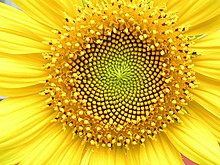Sunflower
Sunflower (Helianthus annuus) is an annual plant native to the Americas. It possesses a large inflorescence (flowering head), and its name is derived from the flower's shape and image, which is often used to depict the sun. The plant has a rough, hairy stem, broad, coarsely toothed, rough leaves and circular heads of flowers. The heads consist of many individual flowers which mature into seeds, often in the hundreds, on a receptacle base. From the Americas, sunflower seeds were brought to Europe in the 16th century, where, along with sunflower oil, they became a widespread cooking ingredient. Leaves of the sunflower can be used as cattle feed, while the stems contain a fibre which may be used in paper production.
DESCRIPTION
What is usually called the "flower" on a mature sunflower is actually a "flower head" (also known as a "composite flower") of numerous florets (small flowers) crowded together. The outer petal-bearing florets (ray florets) are sterile and can be yellow, red, orange, or other colors. The florets inside the circular head are called disc florets, which mature into seeds.
The flower petals within the sunflower's cluster are always in a spiral pattern. Generally, each floret is oriented toward the next by approximately the golden angle, 137.5°, producing a pattern of interconnecting spirals, where the number of left spirals and the number of right spirals are successive Fibonacci numbers. Typically, there are 34 spirals in one direction and 55 in the other; on a very large sunflower there could be 89 in one direction and 144 in the other. This pattern produces the most efficient packing of seeds within the flower head.
Sunflowers commonly grow to heights between 1.5 and 3.5 m (5–12 ft.). The tallest sunflower confirmed by Guinness World Records is 8.0 m (2009, Germany). In 16th century Europe the record was already 7.3 m (24 ft., Spain). Most cultivars are variants of H. annuus, but four other species (all perennials) are also domesticated. This includes H. tuberosus, the Jerusalem Artichoke, which produces edible tubers.


ไม่มีความคิดเห็น:
แสดงความคิดเห็น